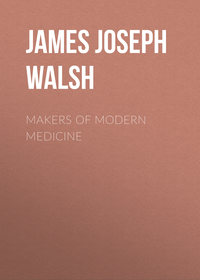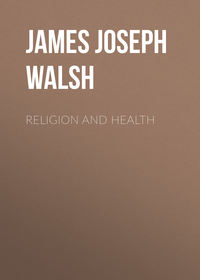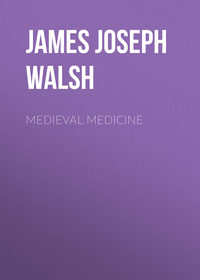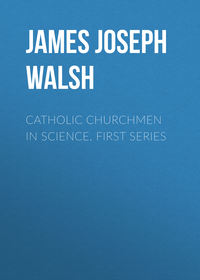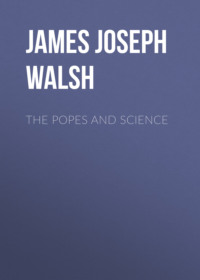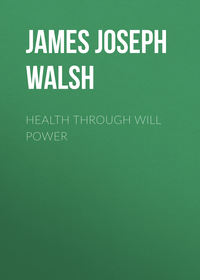 полная версия
полная версияPsychotherapy
Now it is settled that while quinine in small doses is an excellent tonic, it has no effect at all upon fevers in themselves nor upon fever-producing conditions. Yet it is still administered by many who have not quite abandoned the old teachings as if it were a general febrifuge. In the meantime, the use of quinine as a prophylactic of colds and other minor febrile conditions has spread so that many people make themselves very uncomfortable by taking a large dose of quinine and whiskey whenever they fear they are going to have a cold. As a consequence they feel dull and heavy the next day, but assume that they would have been much worse than they are had they not taken the potent remedy the night before. Undoubtedly some of them are enabled by the suggestive value of the remedy and the continued suggestion of its unpleasant effects to throw off the lassitude that comes from some minor infection and are encouraged to get out into the air, when they might otherwise have stayed in the house. This enables them to get rid of their colds sooner than would be the case if they allowed themselves to be confined. Most of them, however, are harmed rather than benefited, and the cold runs its course, unaffected except that the patient is more miserable and depressed for the first day or two than he would otherwise have been. There are physicians who still use quinine as a febrifuge in typhoid and other essential fevers, and doubtless its bitter taste helps their patients because of the suggestive value of an unpleasant medicine.
St. John Long's Liniment.—An interesting exemplification of the power of mystery in adding to the curative value of a commonplace remedy is found in the story of the famous St. John Long liniment. St. John Long was a well-known quack in London in the early part of the nineteenth century. Like all quacks at all times, his specialty was chronic diseases. He claimed to be able by means of external applications to cure the pains and aches to which the old are so likely to be subject. St. John soon acquired an immense reputation. He gave a liniment with a secret formula that was literally a miracle worker. People who used it found after a few times that they were free from, or at least greatly relieved of, aches that had bothered them for years. It was good for sprains and for internal pains of all kinds, as well as for the so-called chronic rheumatisms, which have as their principal symptom pains and aches around joints. So great a reputation, indeed, was acquired by the remedy that an agitation was begun to have Parliament buy the secret from its inventor in order to present it to the British nation. The proposition was actually carried through the legislative chambers and a considerable amount of money, still larger in those days because of the comparatively greater value of money, was voted to St. John Long.
His liniment had a place in the British Pharmacopeia under his name for many years afterwards. It proved to be only a simple old-fashioned remedy, the basis of which was turpentine, and one of the principal ingredients was the white of egg. Just as soon as the secret was known the power of the remedy began to decline. So long as it remained mysterious and unknown, discovered by a man who supposedly had made a special study for many years of these conditions, and had finally worked out the external applications necessary for them, it accomplished wonders. Just as soon as it was known to be a combination of familiar turpentine and egg it lost its power. The remedy is, of course, an excellent counter-irritant, and the gentle rubbing undoubtedly did much good. The most important element, however, was the mental influence, the feeling that now things must be better, which thought distracted attention from the aches and pains and caused the unfavorable influence of over-concentration of mind on the part to cease, for the vaso-motor system is particularly under mental influence. Every now and then since that time some liniment or oil containing nearly the same ingredients as that of St. John Long's acquires a reputation as a consequence of a campaign of advertising. It is the printers ink that counts, however, and just as soon as the advertising ceases to attract attention the remedy fails in efficiency.
Alcohol Plus Suggestion.—Alcohol has been employed in medicine with the persuasion that it is a remedy for many states of exhaustion, though we have gradually gotten away from its use to a great extent, because we realize that subsequent physical ill consequences outweigh, in most cases, the physical good it may do. Its use was undoubtedly due to the confidence of physicians communicated to patients, and the sense of good feeling which it gives and which proves a further strong suggestion to the patient. This sense of well-being is illusory, for it is sure to be followed by a longer period of dejection, which more than counteracts it unless the dose of alcohol can be maintained for some time.
A generation ago few physicians would have cared to treat exhausting diseases, the continued fevers for instance, without liberal doses of alcohol. Practically the only treatment for pyemia and septicemia on which any stress was laid, and in which there was any general confidence, was the administration of alcohol in large quantities. In the septicemia consequent upon puerperal infection it was the common teaching to give alcohol by the tablespoonful or more every hour, or oftener, until its effects began to be noticed, and ordinarily large quantities were required, so that sometimes nearly a quart was taken in the twenty-four hours. Undoubtedly these septic conditions were accompanied by great mental prostration, and this was emphasized by the knowledge that they are often fatal. So patients were usually depressed into a state of mind in which their resistive vitality was much lowered. Alcohol, then, by producing a sense of well-being as well as by stimulating hope in other ways and suggesting possibilities of recovery, undoubtedly exerted a powerful and favorable influence on the mind. Its use in these cases nearly always did good, in spite of its inevitable depressive reaction, for the course of these infections was rapid and the dosage of alcohol could be maintained until there was a change for the better or the fatal termination was in sight.
Alcohol was frequently used in many other conditions of a similar nature, and above all in the septic conditions so common in hospitals before the days of antisepsis and asepsis. When it is recalled that amputations yielded a mortality from sepsis of at least one in four, the extensive use of alcohol in hospital practice two generations ago will be readily understood. We have changed that, however, and Sir Frederick Treves, at a meeting of the British Medical Association at Toronto, five years ago, called particular attention to the statistics of the use of alcohol in British hospitals. During the last forty years milk and alcohol have exactly changed places in the London hospitals. Between 1860 and 1870 about four times as much was spent for alcohol as for milk in these hospitals; during the last decade about four times as much was spent for milk as for alcohol.
A corresponding change has taken place in many other phases of treatment in which alcohol was commonly used. The physician of fifty years ago would have thought that one of his most efficient remedies had been taken from him if he could not use alcohol freely in tuberculosis. There are practically no well-known specialists in tuberculosis now who recommend the use of alcohol. On the contrary, most of them point out the dangers from its use and consider that the depression which follows even a moderate dose is likely to do much more harm than the temporary and fleeting stimulation which it gives can do good. In the treatment of phthisis in recent years milk has done much more than take the place of alcohol: it has displaced it entirely. The medical profession realizes now that what the consumptive needs is not more stimulation—for more of that than is good for him is forced upon him by the toxins of the disease—but more nutrition to enable him to resist the progress of the disease and raise his resistive vitality against its toxemia. The one stimulant that is of service in the affection is oxygen, and even that should be given in nature's dosage rather than by artificial means.
Alcohol in Pneumonia .—A corresponding change has taken place in the professional attitude towards the use of alcohol in pneumonia. There was a time not so very long ago when alcohol was considered the sheet anchor of our therapeutics for pneumonic conditions, especially those in which from the beginning a fatal termination seemed inevitable, because of the age of the patient or some complication. There were physicians who said that if they had to choose between all the drugs of the pharmacopeia on the one hand without whiskey and whiskey without all drugs whatsoever, for the treatment of pneumonia, they would make the latter choice. We are not as yet entirely away from the point of view that attributes a certain value to alcohol in pneumonia, though even those who still employ alcohol are less emphatic in their advocacy of it. Any one who has seen the result of the fresh air for pneumonia patients will think less and less of alcohol. One well-known clinical authority declares that the very best place to treat pneumonia in our cities would be beneath the trees in the parks. Our patients are being treated at the ends of wards with the windows up, on the balconies, and on the roofs, and the death rate is much reduced and the necessity for any other than oxygen stimulation seems much less.
Alcohol in Vague Affections .—The suggestive influence of the effect of alcohol is unconsciously obtained in a number of vague and rather chronic affections. Among these the most noteworthy are women's diseases. Various alcoholic home remedies, gin and whiskey, usually disguised by some bitter, used to be popular. But the known presence of alcohol in these discredited them. Then the nostrum vendors proceeded to supply something just as good. They were, in fact, the same things under another name. Many of the much-advertised remedies that are supposed to cure the ills the weaker sex is liable to, have been found to be little more than dilute whiskey, for in alcoholic strength they were about equal to whiskey diluted once with water, and the other substances were added only to disguise the taste and the odor of this principal ingredient. Many of these remedies have elicited innumerable flattering testimonials and not all of these were fraudulent or obtained by questionable means, but many of them were given because of results secured through the remedies. The alcohol gave the well-known sense of well-being, and the suggestive influence of this increased the appetite, tempted the patient to move around more, and to get more into the air than before, and the consequence was an improvement in the general health, in the midst of which many symptoms that seemed to the excited imaginations of run-down individuals to be serious were relieved. In a great many cases, however, the result was the formation of a whiskey habit; hence the crusade which has discredited these remedies.
Other patent medicines, and, indeed, some of the proprietary preparations, commonly recommended as nutrients and the like, and supposed to be ethical, are found to owe whatever efficiency they have to their alcoholic content. Here once more the suggestive elements were the more important, and enabled substances of little physical efficiency to produce effects that seemed to indicate the presence of powerful energizing materials.
Whiskey in Snake-Bites .—A typical example of a remedy which owes its efficacy to mental influence over the patient is the use of whiskey for snake-bites. It is generally recognized that whiskey is not only of no special beneficial effect for snake-bite, but that when taken in the large quantities usual in such cases it probably produces an ill effect by disturbing the patient's general condition and lowering his resistive vitality. I have no doubt, however, that its use in considerable quantities has in these cases proved of value because of the mental effect upon the patient. Ordinarily a snake-bite is followed by a sense of extreme terror and prostration that lowers the resistive vitality. This is overcome by the temporary stimulation of the alcohol. The generally accepted idea that whiskey is almost a specific remedy for snake-bite takes away from most people this dread and consequent depression, and does this especially at a time when the acuter symptoms of the venom are making themselves felt. Only about one in six even of those bitten by large rattlesnakes are likely to die. Many circumstances are in their favor. The bite is not likely to be fatal unless the full contents of the poison sac is injected—which will not be done if the sac has been emptied in the preceding twenty-four hours—and if there are any obstacles, such as clothing or even hair, on the part struck by the snake. Most people, however, would almost die from fright, and such a thing is quite possible, if they thought there was no remedy. The fact that they understand that alcohol is an almost infallible remedy gives them courage, and as soon as they receive some whiskey and it begins to take effect this intense depression is relieved.
It would be better if the knowledge we now have as to snake-bites were more generally used, and if people understood that only rarely is such an accident fatal. In this way there would be no necessity for an appeal to mental influence through whiskey. It is probable, however, that alcohol will still be used for many years, at least in the country districts, because the supposed knowledge is too widely diffused for a correction to come soon, and then other modes of treatment have not that persuasive mental influence which whiskey has as the result of the long tradition. There are many other popular remedies for snake-bite not quite so inefficient as whiskey, but that will continue to enjoy a reputation and really have a certain efficacious result as a consequence of the expectant attitude evoked by the fact that for as long as the patient has heard anything about these things this particular remedy has been mentioned always as the one thing sure to do good.
Other Cures.—Fontana, toward the end of the eighteenth century, was sure that he had discovered in caustic potash an absolute specific for snake poisoning. He had had a series of cases, and felt that he had actually observed this substance following the snake poison into the system and neutralizing it. Its active effect on the external tissues proved eminently suggestive for the patient and good results followed. We have had many specifics since, and yet we are not quite sure how much any of them avail unless recent biological remedies prove lasting in their effects and are really of therapeutic efficiency.
Antidotes and Suggestion.—For many other poisons beside snake venom there have been announced supposed antidotes of all kinds. The literature of the antidotes used for opium is extremely interesting and even in recent times contains many disillusions. Twenty years ago our medical journals contained any number of cases in which a solution of potassium permanganate seemed to have proved effective in neutralizing not only opium itself but its alkaloids and derivatives. Not only was it efficacious, then, if taken while the opium was still in the stomach but, just as with Fontana's caustic potash and the snake venom, it followed the opium into the tissues and at least blunted its action. Numbers of cases were reported in which potassium permanganate was supposed to have had this desirable effect. The effect of alcohol in neutralizing carbolic acid attracted as much attention as did potassium permanganate for opium. Here there was no doubt that alcohol immediately after the external application of carbolic acid did prevent its corrosive action. It was supposed to do the same thing in the stomach and even, as some enthusiastic observers thought, followed the carbolic acid into the tissues. Here once more the claim is not proven and it is evident that the influence on patients' minds when small doses of carbolic acid were taken, was the real therapeutic factor at work.
Poultices in Suggestive Therapeutics.—Poultices represent another phase of the value of suggestion in medicine and surgery, though for many centuries those who used them were sure that the reasons for their employment were entirely physical and not psychic. All sorts of poultices have been used and each was supposed to do specific curative work. New forms of poultice material have been introduced, and physicians and patients have been certain that each worked wonders of its own. The drawing power of the poultice was extolled until patients dwelt on the idea that this external application was literally engaged in extracting from them, even from distant portions of their anatomy, virulent material that would do harm if allowed to remain in them. Poultices in suitable cases, because they represent moist heat, do good by counter irritation, by bringing about the expulsion of gas, by diverting internal hyperemia to external tissues, but most of their supposed efficacy has been really due to the bother required to prepare and apply them, the discomfort of having them on, and the feeling that now something had been done and the aches and pains must get better. They are still used, but to a much less degree than before. Now the ordinary teaching is that a hot water bag wrapped in dry flannel, if dry heat is the agent desired, and in moist flannel, if moist heat is the desideratum, is much more efficient. It takes but a few minutes for a poultice, no matter how hot when applied—and occasionally in the olden time they were applied so warm as to burn or scald—to decrease in temperature to that of the body. After that they represent only a moist compress.
It is easy to understand that the suggestive influence of poultices might serve for an age that knew less about the realities of the efficacy of external applications than ours. As a matter of fact, we have, nevertheless, shown ourselves to be quite as credulous and ready to receive analogous remedies as the past generation. With the waning of the popularity of the poultice, not only among the profession, but also among the people generally, there came into use various plasters which were supposed to have even more wonderful efficacy than the poultice of the olden time. These required a good deal of trouble to apply and once applied remained on for hours, and so continued to produce a definite curative effect on patients' minds. When first introduced, exaggerated claims were made for their therapeutic value and a regular crusade to diffuse correct information regarding them had to be made, in order to set them in their proper place as mere wet compresses, without any therapeutic efficiency beyond that of cloths wrung out in water and kept in touch with the skin.
Poultices and the Doctrine of Signatures .—There was a general impression in the past that the indication of the ailment for which substances are medically useful has been set on them by nature, either through the color, or the form of the plant, or other qualities. In general, the law of similars is supposed to hold in the doctrine of signatures—like cures like. Hence the cornmeal poultice for light jaundice, the flax-seed meal poultice for darker jaundiced conditions and for tendencies to gangrene. The charcoal poultice was employed for this same purpose with no better reason, though some of its efficacy may have been due to oxygen present in the pores of the charcoal. I have already spoken of the appeal to the patient's mind in the use of the cranberry for erysipelas, and various other berries were used in like manner on the doctrine of signatures.
Deterrent Materials and Suggestion .—Another basic principle in the making of poultices was the use of deterrent, repulsive materials, because these were more effective on the patient's mind. All the ordures were so employed. Goose and chicken excrement was supposed to be particularly efficacious for many of the purposes for which we now use iodine. It was applied over sprains and bruises on the unbroken skin. Cow-dung was employed as a poultice for sprains of the larger joints, especially on the feet and legs, but to be efficacious it had to be applied fresh. I have known, within twenty years, of physicians in two so supposedly cultured parts of the country as Pennsylvania and Maryland, to employ such ordure poultices for the cure of sprains and dislocations, and these physicians had a great reputation among the people of their countryside. They were known especially as good bone doctors, and their use of such deterrent materials instead of decreasing their practices rather added to them.
Ointments.—In the Middle Ages ointments made of the most far-fetched materials were employed even by distinguished surgeons. That, indeed, is the one serious flaw in the surgery of the thirteenth and fourteenth centuries, when they did everything else so well. These ointments contained all manner of materials that were likely to impress patients and make them feel that something wonderful was being done for them. Crushed insects of all kinds were employed for external lesions. Here the doctrine of similars seems once more to have been in play. Insects gave creepy feelings, and whenever such feelings, or the paresthesiae generally, were complained of, a poultice or ointment made of insects seemed to be the natural remedy. The more repellent the materials, the more efficient they were likely to be. Many of the paresthesiae are due to neurotic conditions and it is not surprising that when an ointment of crushed lice—these insects being collected from barnyard fowls or from hogs—was used, the suggestive influence was strong. Another important ingredient in ointments were portions of dead bodies. A bit of a mummy from the East was supposed to be particularly efficacious. Portions of the bodies of men who had been hanged, or of the moss that grew on the skulls of malefactors whose bodies had been long exposed in chains to the air, were also favorite ingredients. Plants and shrubs gathered in graveyards, especially in the dark of the moon, because on account of the terror of the place they were then harder to get, also had a great reputation.
CHAPTER IV
SIGNATURES AND PSYCHOTHERAPY
Similia similibus curantur , like is cured by like, is a very old idea. According to the doctrine of signatures nature had put an external natural marking or a symbolical appearance or characteristic upon a plant, mineral or other object, to indicate its special usefulness for the treatment of certain diseases or for affections of certain organs. Sir Robert Boyle, sometimes spoken of as the father of chemistry, said, "Chymists observe in the book of nature that those simples that wear the figure or resemblance, by them termed signature, of a distempered part, are medicinal for that part or that infirmity whose signature they bear." On this principle yellow flowered plants were good for jaundice, because they resembled it in color. The blood stone was good for hemorrhage, and plants of certain forms were good for the organs or parts of man which they resembled. Certain plants were named with this idea. Kidneywort, liverwort, are typical examples. Scorpion grass, our familiar forget-me-not of the genus myosotis, was so-called because its spike resembled a scorpion's tail and was, therefore, good against the scorpion's sting, or against pains similar to that produced by such a sting. Some of the resemblances were extremely far-fetched, but in spite of the defect of nature's signature on them, they seem to have been effective in therapeutics. The plant, sometimes called Jew's ear, which can by an effort of the imagination be made to bear resemblance to the human ear, was, for instance, supposed to be a successful cure for diseases of that organ.
We know now that there is no significance in this doctrine of signatures. It represented one phase of pseudo-science. But the idea of itself was enough to help people to throw off many symptoms, to relieve discouragement, to encourage them with the thought that they ought to get better; accordingly they took new heart, ate better, went out more, and as a result naturally slept better, and then nature did the rest. Signatures are an exquisite example of pure psychotherapy, as the initial agent and natural curative methods accomplishing the cure.




